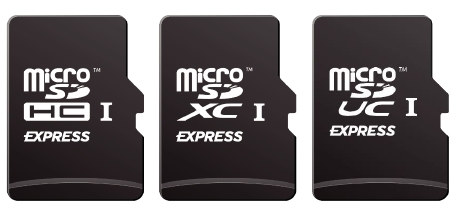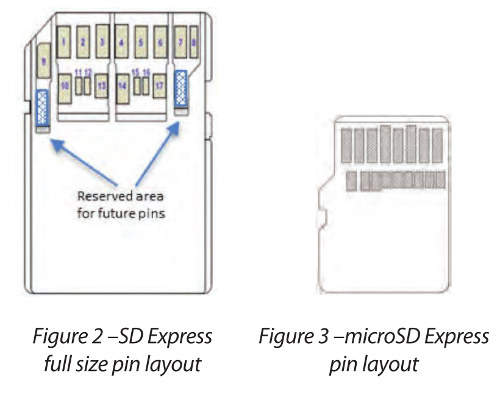Last Summer the SD association released SD 7.0 specification with two key new features: SD Express adding PCIe and NVMe interfaces to the legacy SD card interface for transfer rates of up to 985MB/s, and SDUC (SD Ultra Capacity) card allowing capacities of up to 128 TB. This all looks great, but while the latter was available for both micro SD cards and full size SD cards, microSD cards could not benefit from the new high speed interfaces part of SD Express specification.
SD 7.1 specification fixes that, as the SD association has now added microSD Express card which will also be able to reach up to 985MB/s (in theory) thanks to PCIe/NVMe interfaces, so we’ll be able to get sort of “removable SSDs” for smartphone and other devices that compatible with SD Express.
 As illustrated above microSD Express cards will be available in various capacities as microSDHC Express, microSDXC Express and microSDUC Express cards.
As illustrated above microSD Express cards will be available in various capacities as microSDHC Express, microSDXC Express and microSDUC Express cards.
Beside the higher transfer rate, and larger capacities we can expect from such microSD cards, PCIe3.1 also includes the low power sub-states (L1.1, L1.2) enabling low power implementations of SD Express, and as a result, (micro)SD Express cards are expected to consume less energy than traditional microSD memory cards while keeping the same maximum consumed power.
 Both SD Express and microSD Express cards are currently powered by 3.3V and 1.8V, but an optional 1.2V supply is planned for the future with additional pins for both form factor. More technical details about (micro)SD Express card can be found in this white paper.
Both SD Express and microSD Express cards are currently powered by 3.3V and 1.8V, but an optional 1.2V supply is planned for the future with additional pins for both form factor. More technical details about (micro)SD Express card can be found in this white paper.
AFAIK, nor SD Express, microSD Express cards, or host devices that support SD Express specification are available for sale. The best microSD cards money can (soon) buy are SanDisk Extreme microSDXC UHS-I card and Micron c200 1TB microSDXC UHS-I card both with 1TB capacity, and transfer rates of around or slightly above 100MB/s.

Jean-Luc started CNX Software in 2010 as a part-time endeavor, before quitting his job as a software engineering manager, and starting to write daily news, and reviews full time later in 2011.
Support CNX Software! Donate via cryptocurrencies, become a Patron on Patreon, or purchase goods on Amazon or Aliexpress




